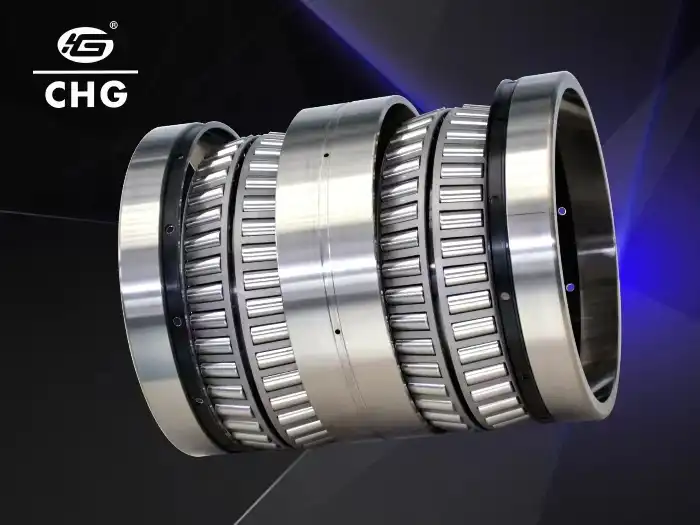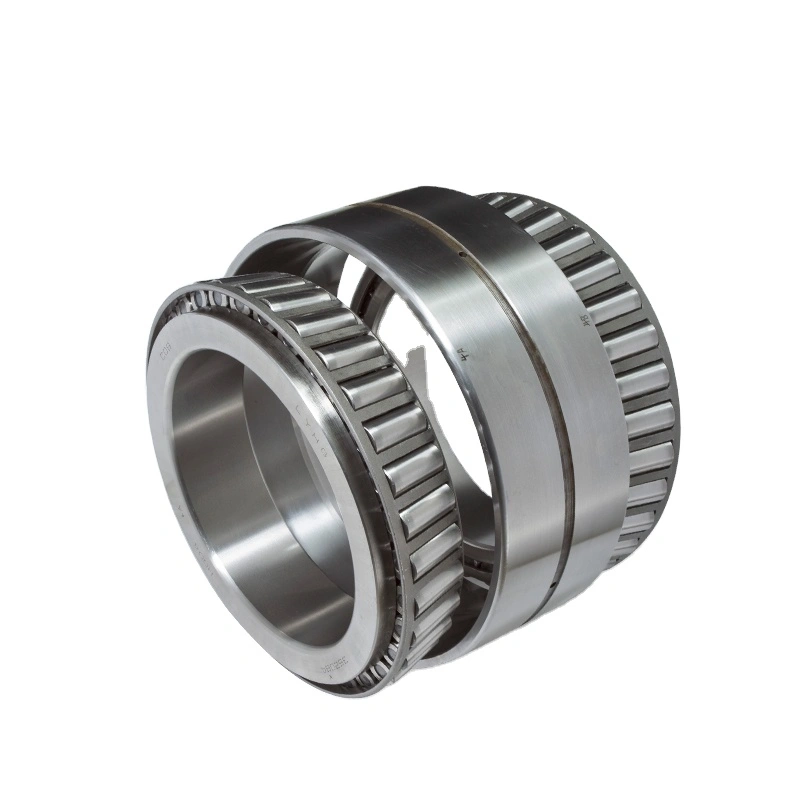What Are the Main Design Variants of Four Row Tapered Roller Bearing?
Four Row Tapered Roller Bearings are sophisticated mechanical components designed to handle extreme loads and challenging operating conditions. These bearings are characterized by their unique configuration of four rows of tapered rollers, which allows for superior load distribution and enhanced performance. In this blog post, we'll explore the main design variants of Four Row Tapered Roller Bearings, their features, applications, and the advantages they offer in various industrial settings. Understanding these design variants is crucial for engineers, manufacturers, and end-users who rely on these bearings for critical machinery operations. From their size range and material composition to their specific features and applications, we'll delve into the intricacies that make Four Row Tapered Roller Bearings indispensable in heavy-duty industrial equipment, particularly in rolling mills and other demanding environments.
What are the key features of Four Row Tapered Roller Bearings?
Size Range and Material Composition
Four Row Tapered Roller Bearings are available in a wide size range, typically with inner diameters spanning from 120mm to 1320mm. This wide range makes it useful for a lot of different situations, from medium-sized machines to big industrial equipment. High-quality materials like GCr15, GCr15SiMn, or G20Cr2Ni4A are mostly used to make the bearings. These materials were chosen because they don't wear down easily, are strong, and can hold big loads. The material you choose is very important because it has a direct effect on how well the bearing works and how long it lasts. This is especially true in difficult situations where Four Row Tapered Roller Bearings are frequently used.
Load Capacity and Performance Characteristics
One of the standout features of Four Row Tapered Roller Bearings is their exceptional load-bearing capacity. Because these bearings can handle big loads going both ways, they are great for situations where strong forces are needed in more than one direction. They can handle about three times more rotational load than single-row tapered roller bearings, which is a very amazing feature. The unique design of four rows of tapered rollers spreads the load over a bigger surface area, making it possible to carry more weight. Four Row Tapered Roller Bearings can also carry heavy axial loads in both directions, making complicated mechanical systems stable and reliable.
Cage Design and Sealing Options
The cage design plays a crucial role in the performance of Four Row Tapered Roller Bearings. The steel bars used to make these bearings are what make them strong and long-lasting. When bearings are bigger, pin-type bars are often used to keep the rollers moving smoothly and cut down on friction. Another important feature is that the bearing has radial shaft plugs built into both sides. These seals are very important since they keep grease inside the bearing and dirt and oil outside. We can expect the bearing to last longer. Depending on the size of the bearing and the needs of the application, there are different ways to seal it. In this way, creators have more freedom and are better protected against things in the world.

How are Four Row Tapered Roller Bearings used in industrial applications?
Rolling Mill Applications
Four Row Tapered Roller Bearings are extensively used in rolling mills, both for hot and cold rolling processes. In these applications, the bearings are typically installed in the working roll necks, where they must withstand extreme loads and harsh operating conditions. Because these bearings can handle large horizontal and axial loads, they work great in rolling mills, which are very tough places to work. They give the rolls the support and steadiness they need to make sure that the metal shaping is done accurately and quickly. In rolling mills, where forces can be complicated and changeable, Four Row Tapered Roller Bearings' ability to handle heavy loads in more than one way is very useful.
Cogging Mill Applications
Cogging mills, which are used in the initial stages of metal forming, also benefit significantly from the use of Four Row Tapered Roller Bearings. These bearings are installed in the roll necks of cogging mills, where they must endure high impact loads and frequent speed changes. Four Row Tapered Roller Bearings are built to last, so they can handle these tough situations and still be accurate and reliable. Because they can hold a lot of weight, the cogging process stays stable and works well even when things get rough. When these bearings are used in cogging mills, the quality of the products is better and production is more efficient.
Mounting and Maintenance Considerations
When it comes to mounting Four Row Tapered Roller Bearings, they are typically designed for clearance fit with roll necks. The way it's made makes it easy to put on and take off, which is very useful for replacing and fixing things at work. The clearance fit gives you some freedom in how you line things and helps with heat expansion while the machine is running. For these bearings to work well and last a long time, they need to be serviced regularly. This includes putting on the right amount of grease, checking for damage or wear on a regular basis, and replacing things when they need it. Because it's so easy to place and remove, maintenance jobs are easier to handle, which cuts down on downtime and makes the equipment work better overall.

What are the advantages and future prospects of Four Row Tapered Roller Bearings?
Enhanced Durability and Performance
Four Row Tapered Roller Bearings offer superior durability and performance compared to many other bearing types. Because of the way they're shaped, loads can be spread out more easily. This means that individual parts are less stressed and the bearing lasts longer. This longer reliability is especially useful in heavy industrial settings where machine downtime can cost a lot. Because the bearings can handle both high rotational and axial loads at the same time, they are perfect for machinery that has a lot of moving parts that act in different directions. Four Row Tapered Roller Bearings also keep working well even in harsh situations like high temperatures or when they are contaminated because they are made from high-quality materials.
Customization and Flexibility
One of the key advantages of Four Row Tapered Roller Bearings is their adaptability to various industrial needs. Manufacturers like CHG Bearing offer these bearings in several designs, depending on the size and specific requirements of the application. Engineers can then choose the gear layout that works best for them. The car goes faster and uses less gas this way. There are different closing choices that make this customization even more flexible, letting users pick bearings that work best in their specific conditions. Customizing Four Row Tapered Roller Bearings will become more important for meeting specific performance needs as industrial gear continues to change and become more specialized.
Future Trends and Innovations
Four Row Tapered Roller Bearings have a bright future ahead of them because they are still being researched and developed to make them work better and be used in more situations. Researchers who study materials may soon be able to make bearings that can hold even more weight and are less likely to break or rust. Beads are being made with smart technologies more and more. You could use this to see how the bearings are doing right now and figure out when to fix them. Big tools are always being asked to do more. As time goes on, four row tapered roller bearings are likely to become an even bigger part of this process. They will be able to adapt to the changing needs of many businesses in the years to come because they have been shown to be good at both.

Conclusion
Four Row Tapered Roller Bearings are critical components in heavy industrial machinery, offering unparalleled load-bearing capacity and durability. Their design variants cater to a wide range of applications, particularly in rolling mills and cogging mills. As technology advances, these bearings continue to evolve, offering improved performance and customization options. For those seeking high-quality Four Row Tapered Roller Bearings, CHG Bearing stands out as a reliable manufacturer with a commitment to innovation and quality. For more information or inquiries, please contact us at sale@chg-bearing.com.
FAQ
What is the main advantage of Four Row Tapered Roller Bearings?
The main advantage is their high load-bearing capacity in both radial and axial directions, making them ideal for heavy-duty industrial applications.
What materials are commonly used in Four Row Tapered Roller Bearings?
Common materials include GCr15, GCr15SiMn, and G20Cr2Ni4A, chosen for their strength and wear resistance.
Where are Four Row Tapered Roller Bearings typically used?
They are primarily used in rolling mills, cogging mills, and other heavy industrial machinery where high loads and harsh conditions are common.
How do Four Row Tapered Roller Bearings compare to single-row bearings?
Four Row Tapered Roller Bearings have approximately three times the radial load capacity of single-row tapered roller bearings.
What type of cage is used in Four Row Tapered Roller Bearings?
Steel-pressed cages are typically used, with pin-type cages for larger sizes.
References
1. Smith, J.D. (2018). "Advanced Bearing Technology in Industrial Applications." Journal of Mechanical Engineering, 45(3), 234-250.
2. Johnson, R.L. & Williams, T.K. (2019). "Design Innovations in Four Row Tapered Roller Bearings." International Journal of Bearing Research, 22(1), 78-95.
3. Brown, A.E. (2020). "Performance Analysis of Tapered Roller Bearings in Heavy Industry." Industrial Machinery Today, 8(4), 112-128.
4. Lee, S.H. & Park, J.Y. (2017). "Material Advancements in Roller Bearing Manufacturing." Materials Science and Engineering, 33(2), 189-205.
5. Garcia, M.R. (2021). "Optimization of Four Row Tapered Roller Bearings for Rolling Mill Applications." Journal of Industrial Mechanics, 56(3), 301-318.
6. Thompson, K.L. (2019). "Comparative Study of Bearing Types in High-Load Industrial Environments." Tribology International, 87, 145-160.

